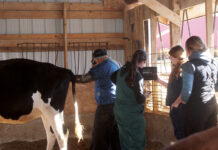WOOSTER, Ohio — A two-part CBS Evening News series on the use of antibiotics on the farm has spurred much anticipated concern among consumers and the farm community.
The series concluded the evening of Feb. 10 with an interview of a Danish hog farm and a Pennsylvania turkey farm, where antibiotics are not administered in feed. According to those producers, not using antibiotics results in more costly production, but healthier animals and a healthier bottom line.
Important tool
But major farm groups, including the National Pork Council, say antibiotics have their place on the farm, and have been in use since at least the 1940s. Among those featured in the series, which was anchored by CBS’ Katie Couric, was National Pork spokesperson Liz Wagstrom, a veterinarian who covers public health issues.
According to Couric’s report, no country uses as much on-farm antibiotics as the United States. Since recently banning feed-grade antibiotics, Denmark’s hog farmers are reportedly doing well and producing healthier hogs.
But other reports show hog mortality has risen, and the number of Danish hog farmers to be on a sharp decline.
“If we did the same thing in the United States, we’d have more sick and dying pigs,” Wagstrom said.
According to Feedstuffs FoodLink — an online news source covering livestock and feed issues — the number of Danish pork producers will be about 5,000 in 2015, down from 25,000 producers in 1995. Several small farmers have gone out of business, while larger producers were able to survive.
The publication quotes House Agriculture Committee Chairman Collin Peterson, D-Minnesota, after returning from a congressional trip to Denmark to meet with its government and farmers: “We didn’t come back with a definitive answer on this complicated issue because we found no scientific evidence that reducing antibiotic use in agriculture has resulted in public health benefits in Denmark.”
John Waddell, a veterinarian from Sutton, Nebraska, raised the question on the minds of many farmers: Is reducing antibiotic use affordable, and what are the health consequences?
“Since the Danish ban on antibiotics, the number of foodborne illness cases has risen,” he said. “Even at best, per capita numbers have not decreased. Therefore, there’s at least a ‘reasonable certainty’ that any public health benefit from reducing antibiotic use would be offset by eliminating production efficiencies that make protein more affordable and, thus, improve the overall quality of diets.”
A link, or a correlation?
In her report, Couric linked use of antibiotics on farms to heightened cases of MRSA — an antibiotic-resistant staph infection — occurring most frequently in people who have been exposed to hospitals and healthcare facilities.
Wagstrom scrutinized Couric’s suggestion that the occurrences were connected, or that they were anything more than a correlation.
MRSA, as it is known, is “totally unassociated with animal production,” Wagstrom said on AgriTalk Radio, following the first segment of the series. “I think that the story last night gave the impression that MRSA is associated with livestock and we know that that’s simply not the case.”
Many of the scientists Couric interviewed believed the more bacteria are exposed to antibiotics, the more opportunity they have for developing resistance, potentially developing into “superbugs,” the term used to describe antibiotic-resistant infections.
Bacteria resistance
Shelley Hearne of the Pew Charitable Trust, said resistant bacteria can spread through the food supply, from water runoff and through the air.
“It’s why it’s a practice that has to stop on the farm,” she said.
The National Pork Council says antibiotics are a necessary part of protecting the health and efficiency of pork production.
“Current and future availability of safe and effective animal health products are important to pork producers, who depend on these products to maintain healthy and productive animals and to help producers protect public health and animal well-being.”
It points out that the Food and Drug Administration must approve drugs before they can be used on farms, which has been the case with farm-level antibiotics.
According to Couric’s report, reducing feed-level antibiotics would cost producers about $5 more per 100 pounds of pork, and consumers could expect to pay about 20 cents more per pound of turkey leg meat.
Updates to this story are forthcoming.









